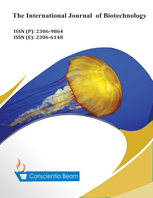Bioremediation of Palm Oil Mill Effluent (POME) Polluted Soil Using Microorganisms Found in Organic Wastes
Abstract
The aim of this study was to demonstrate the use of chicken droppings and cow dung in the amendment of soil polluted with palm oil mill effluent (POME) in bioremediation. Soil polluted with 20 % raw (POME) in the laboratory was amended with different concentrations of chicken droppings, cow dung and a combination of the wastes (10 %, 20 % and 30 %). Isolation, characterization and identification of microorganisms were carried out and compared over time with respect to the different concentrations. Gas chromatography mass spectroscopy (GCMS) analysis of extracts of POME polluted and amended soil indicated a reduction in the number of long chain hydrocarbons (C13-C44) in POME polluted soil to C8-C21 in amended soil. This was attributed to the presence of microorganisms of the genera Pseudomonas, Bacillus, Proteus, Micrococcus, Aspergillus, Penicillium, Paecilomyces and Candida in significant numbers throughout the period of analysis. However, a combination of the two organic wastes at 20 % concentration was most effective in this reduction. The implication of these findings is that the bacteria, mould and yeast isolates found in these organic wastes can be useful in rehabilitation of POME polluted soil and possibly other oil polluted sites.

